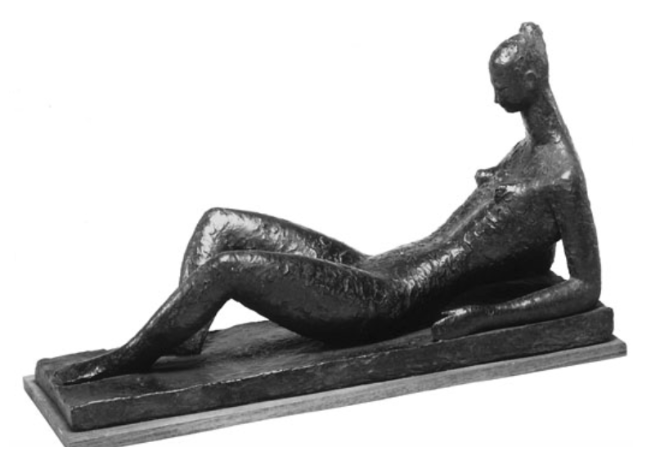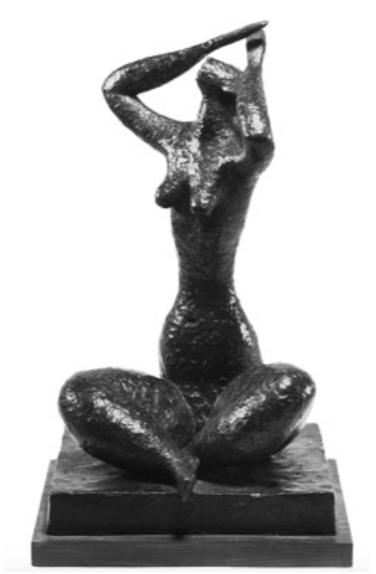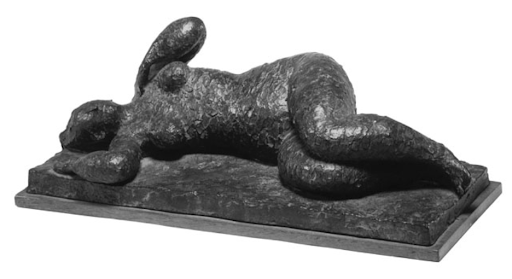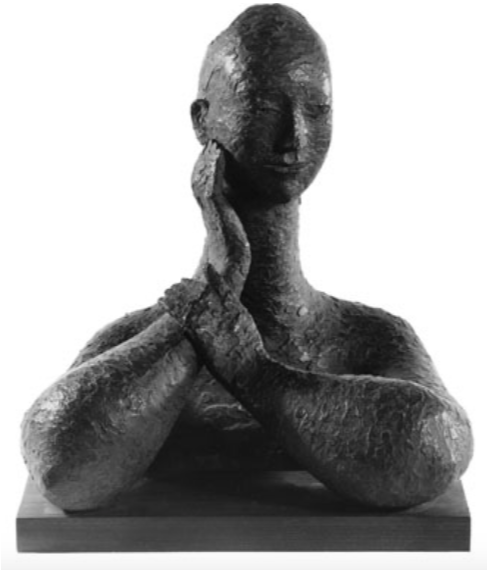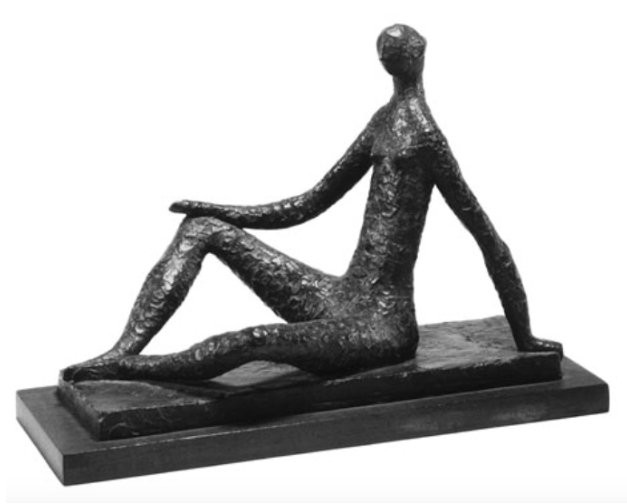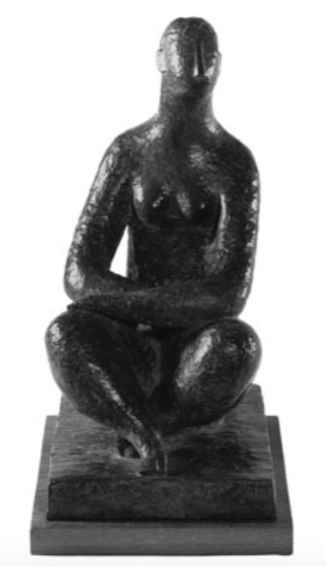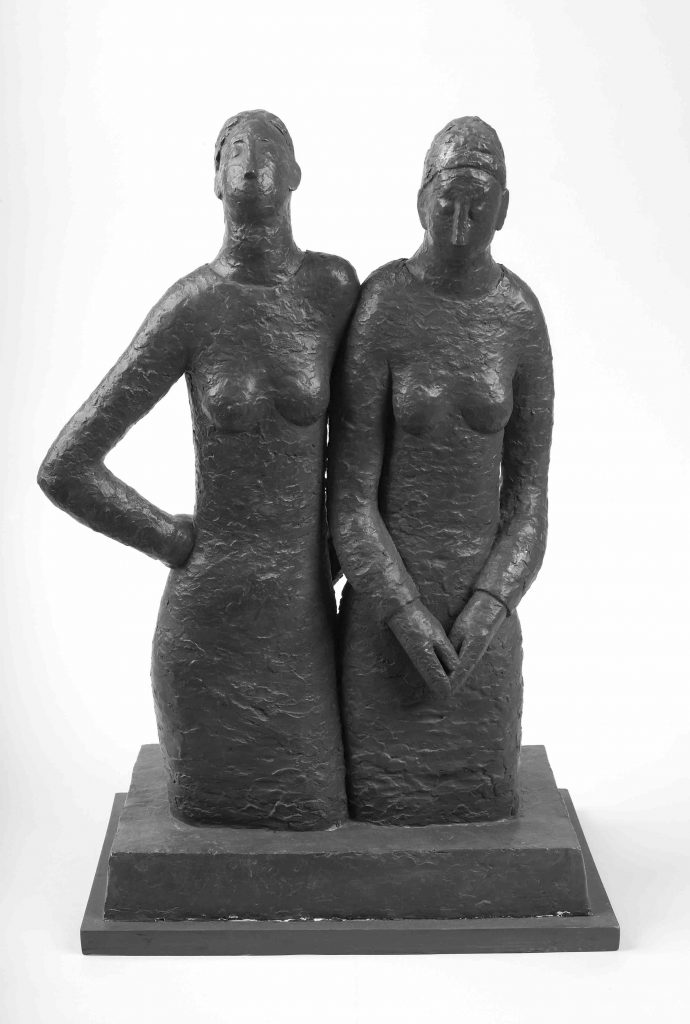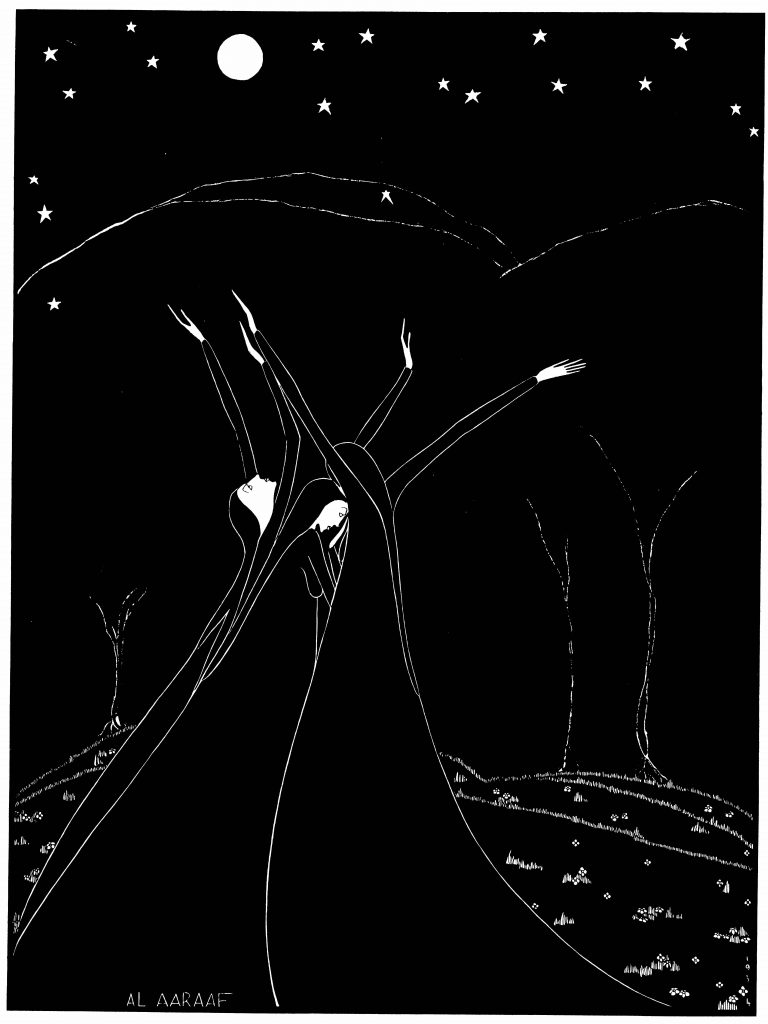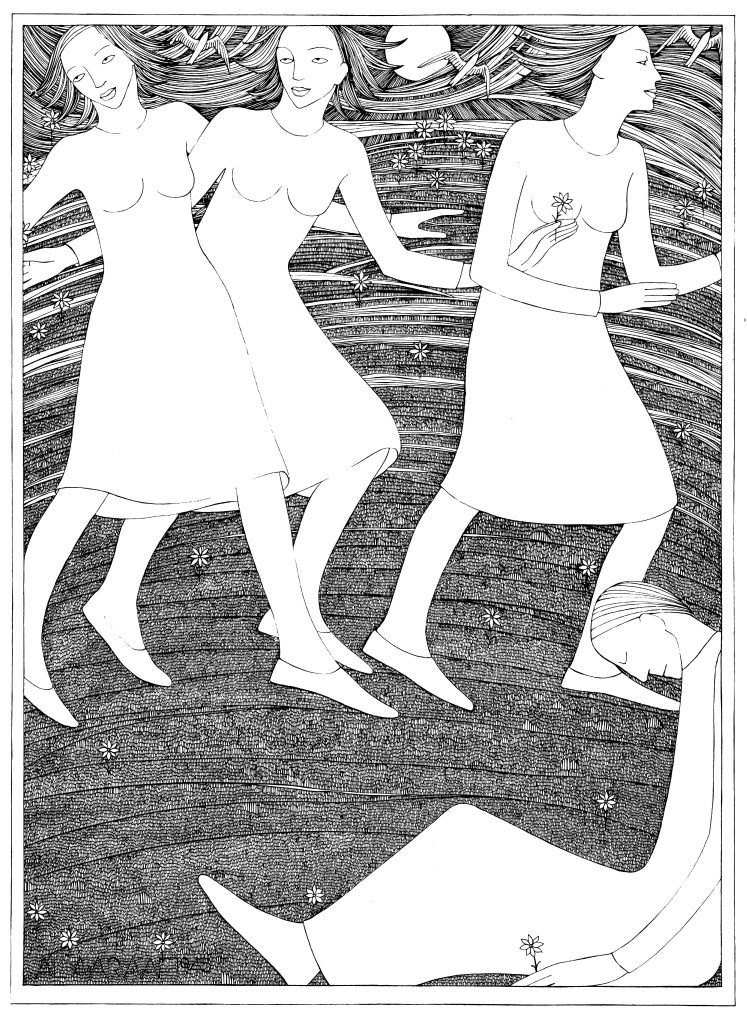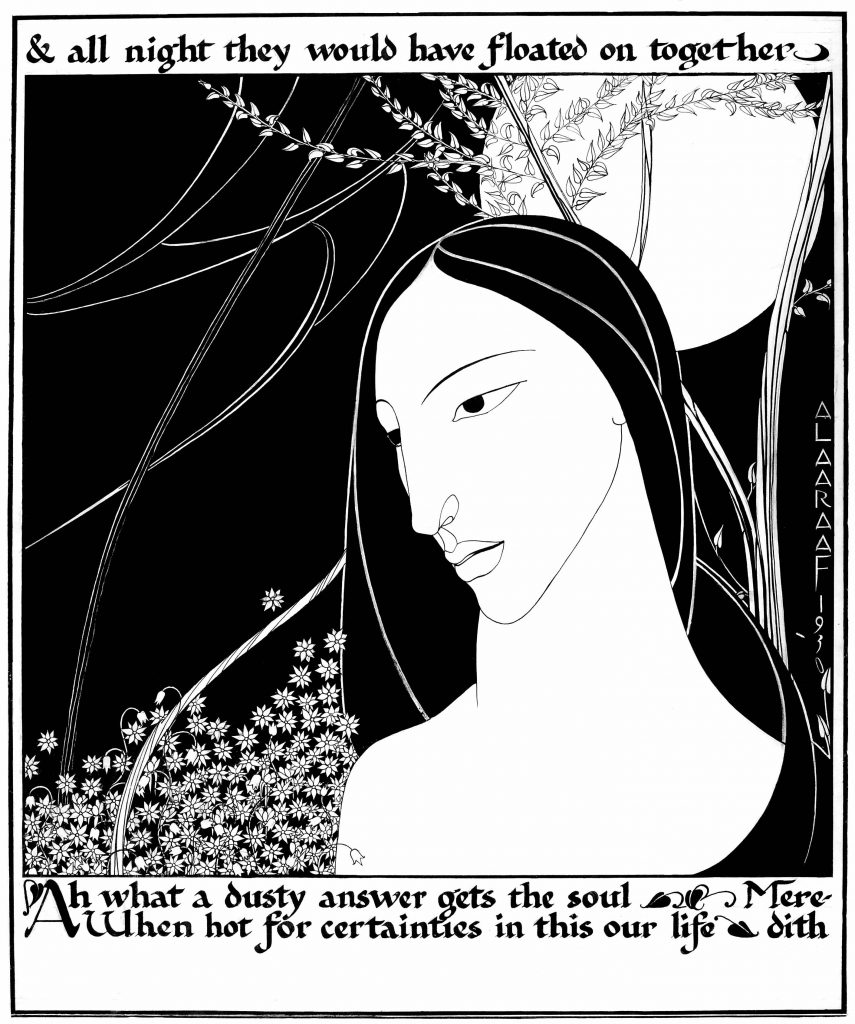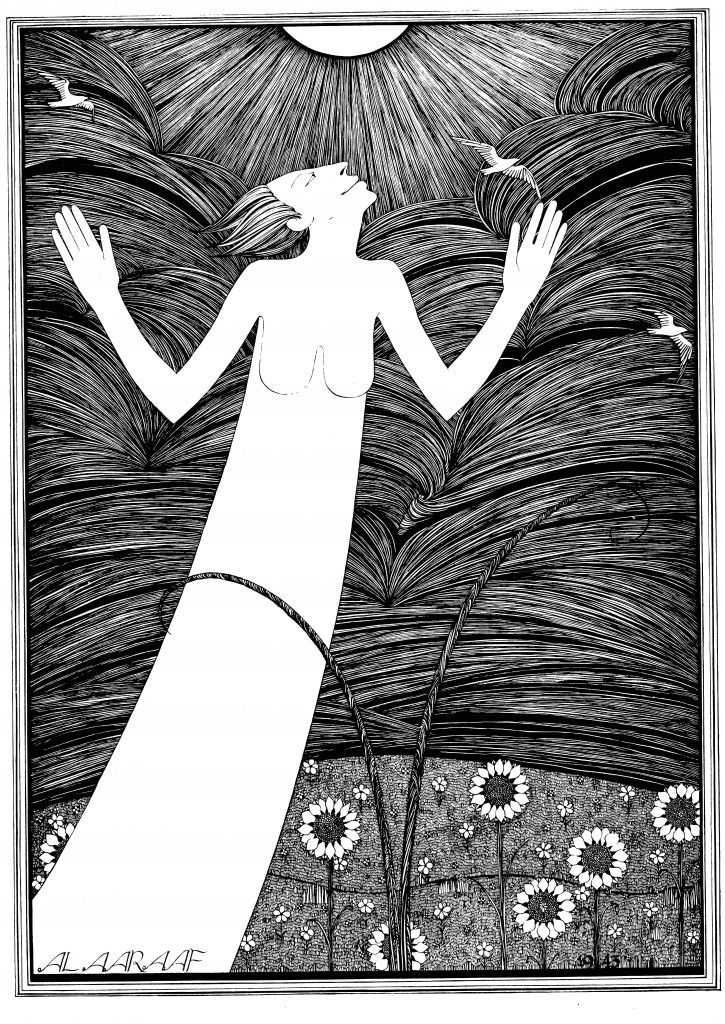Sculptures
Woman Resting (1962)
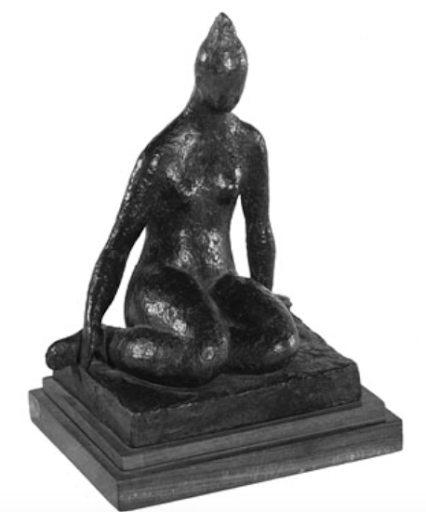
Woman Resting was created in 1962 by Hannah Frank.
This work is called Woman Resting and was created in 1962.
The sculpture shows a woman sitting on a plinth. Her legs are mostly tucked under her body. She is leaning on her left arm and as a result her body leans towards the left. Her legs are large and curved. Her knees come forward and fill the front of the plinth. Her lower right leg and foot point out over the edge of it. Her torso is thin and she has small breasts. Her right arm reaches towards her right foot and touches the edge of the plinth. Her left arm reaches slightly behind her and leans on the space by her thigh. Her head is small and her gaze is pointed down. Her face is largely undetailed. She has a simple bun on the top of her head.
As part of the Hannah Frank 110th Birthday Exhibition embroidery artist Myra Ostacchini wrapped one bronze version of this sculpture in bright threads of many different colours.
Reclining Woman (1964)
Reclining Woman was created in 1964 by Hannah Frank.
Reclining Woman was created in 1964 by Hannah Frank. It depicts a woman reclining back onto her arms.
The bottom of her back meets the floor. Her curved legs reach up and away from each other. At her angular knees, her legs bend and her feet travel to the ground. Her left foot is stretched further and her right foot rests slightly behind. Her elongated torso shows two small, pointed breasts. Her arms travel straight down and her forearms rest on the ground, holding up her torso. Her neck is elongated and reaches a small head. She has a curved nose and small ears and mouth. Her eyes look towards her body. She has a small bun on the top of her head. This work is one of many created by Hannah Frank based on the subject of a reclining figure. It is also one of the first sculptures to show Hannah Frank’s move away from a naturalistic style to a more abstracted style in which her figures are often proportionally abstracted and elongated. This work was exhibited at the Royal Glasgow Institute and Royal Scottish Academy.
Bird Woman (1969)
Bird Woman was created in 1969 by Hannah Frank.
In 1969 Hannah Frank created Bird Woman, a sculpture of which several bronze casts have been made. It is 43.2 cm tall.
A woman sits cross-legged on a plinth. Her right foot is at the front and juts over the edge. Her legs are curved and soft with angular knees and flat feet. Her wide hips rise and curve to create a thin waist. The length of the torso is exaggerated and at the top of it are the woman’s breasts which hang down. She has her head tilted up to the sky and her arms reach up too. They bend sharply at the elbows, bringing her forearms close to her face. The woman brings her hands over her face.The sculpture Woman with Bird of 1955 is very similar in terms of composition. This work was exhibited at the Royal Glasgow Institute.
Seated Figure (1973)
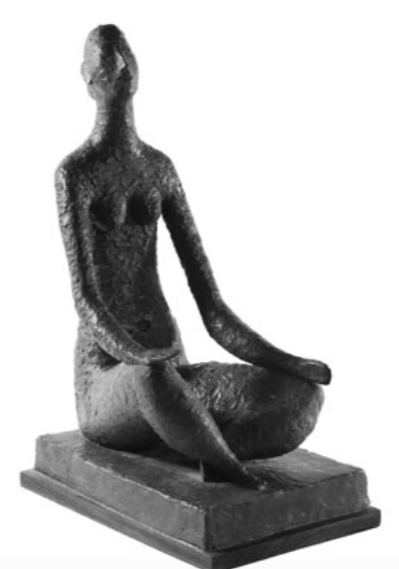
Seated Figure was created in 1973 by Hannah Frank.
This work is called Seated Figure and was created in 1973 by Hannah Frank. This is one of many works created by Hannah Frank which has the title Seated Figure. It shows a woman sitting.
Her legs are very round and large. They stretch out in front of her and bend at the knees. Her feet come to rest under her knees. The figure has a very thin torso which is detailed with a belly button and small breasts. Her incredibly long arms stretch down and rest on her knees. The woman’s head is detailed simply and is pointed slightly up. Her hair is gathered in a bun at the bottom of her head.
Waiting Woman (1978)
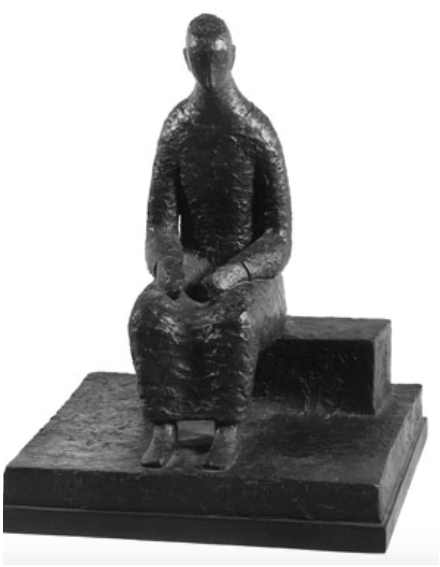
Waiting Woman was created in 1978 by Hannah Frank.
This sculpture depicts a solitary figure sitting on a block. It is called Waiting Woman and was made in 1978. This version is made of plaster and is 38 cm high.
On the back right hand corner of the plinth is a rectangular bench. On the left hand side of this bench, in the centre of the composition, is a female figure. She sits on the bench with her torso upright. The woman wears a dress, which reaches from her ankles to her wrists. Her head is an oval shape and gazes down into her lap. Apart from her nose and her ears, there is very little detail on her face. Her arms fall to her lap and her hands rest on her thighs. The figure’s legs, the form of which is visible through her dress, run parallel to each other. Her feet sit a short distance away from each other, with their soles on the floor. This work was exhibited at the Royal Glasgow Institute.
Seated Figure (1981)
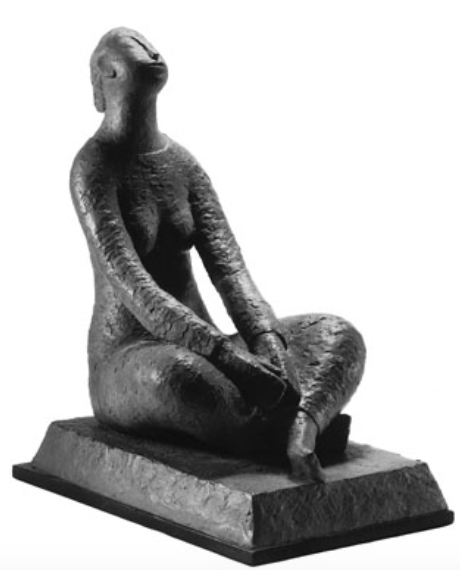
Seated Figure was created in 1981 by Hannah Frank.
This plaster version of the sculpture Seated Figure, which was created in 1981. It is one of many sculptures created by Hannah Frank with the name Seated Figure and it is 38 cm high.
The sculpture depicts a woman sitting on a plinth. Her head is oval shaped and is gazing up. Her hair is in a bun at the nape of her neck and her eyes are shut. The woman is wearing a long dress which covers her from her ankles to her wrists. The form of her breasts is visible through this dress. Her left ankle crosses over her right ankle and her knees push out. In her lap, the figure’s hands meet. This work was exhibited at the Royal Glasgow Institute.
Seated Figure (1987)
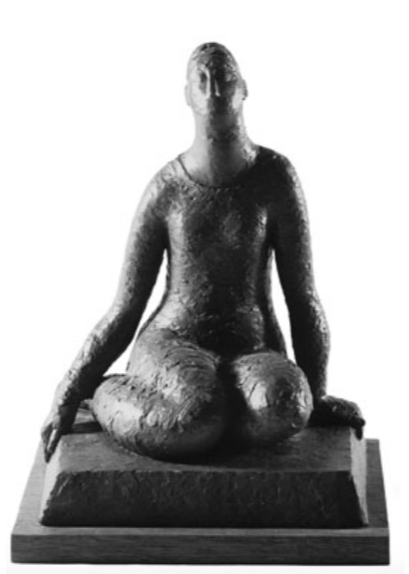
Seated Figure was created in 1987 by Hannah Frank.
This work is called Seated Figure and was created by Hannah Frank in 1987. This is a plaster version of the sculpture which measures at 30.5 cm.
The sculpture depicts a woman sitting with her legs tucked under her. She leans on her left arm. Her hand holds the edge of the plinth. She leans slightly to the left and the bottom of her right leg starts to come out from under her. The figure’s right arm rests next to her right leg, also holding onto the edge of the plinth. The woman is wearing a dress which obscures most of her body, although the form of her breasts is still visible. She’s looking directly at the viewer, her face passive and simply designed. This work was exhibited at the Royal Glasgow Institute.
Reclining Woman (1963)
Reclining Woman was created in 1963 by Hannah Frank.
This sculpture is called Reclining Woman. It exists in plaster and bronze. It is 12.8 cm tall and is from 1963.
This sculpture is the first of many sculptures focussed on the subject of a reclining woman. The woman is voluptuous and depicted as lying on her side. Her right hip meets the floor. Her knees fall together to the right hand side of her body. Her feet are touching, with the left foot lying on top of the right foot. The figure’s torso twists towards the left hand side as she lowers her left shoulder to meet the floor. Her left breast rises upward and her right breast lowers towards the floor. Her right arm is resting on the floor and reaches towards the woman’s head, which is detailed with simple facial features. Her shoulder rises up. Her arm bends at the elbow and her hand reaches towards her shoulder. This work was exhibited at the Royal Scottish Academy. Hannah Frank’s career as a sculptor started in 1952 after the artist attended sculpture classes at the Glasgow School of Art in an attempt to improve her knowledge of anatomy for her drawings.
Pensive Head (1968)
Pensive Head was created in 1968 by Hannah Frank.
This work is called Pensive Head and was made by Hannah Frank in 1968.
Pensive head is an example of Hannah Frank’s move away from the biographical, naturalistic busts of her early sculptures and towards busts with more elongated features, something she had already been experimenting with in her sculptures of full figures. Like her sculpture Sleeping Head from 1958, the bust begins just above the breasts of the figure. Her arms are stretched out towards the viewer and at the elbows her forearms turn inwards and towards the face of the figure. Her right arm stretches up and cups her right cheek. Her left arm reaches and holds her right wrist. The figure has a long neck and an oval shaped face, which is slightly turned to the left. Her facial features are defined. This work was exhibited at the Royal Glasgow Institute and the Royal Scottish Academy.
Seated Figure (1970)
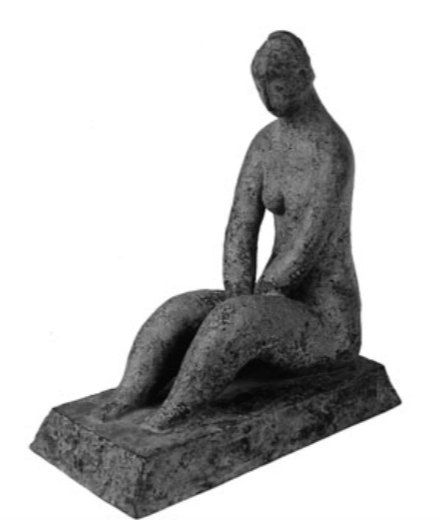
Seated Figure was created in 1970 by Hannah Frank.
This sculpture is called Seated Figure. A plaster cast and bronze casts exist of this piece. This particular work is made of plaster. It measures at 34 cm tall and was created in 1970.
Depicted is a woman sitting with her legs outstretched. Her feet lie flat on the ground and seem to meld into the plinth. Her form is very soft and her shins curve gently into her knees which then curve into her thighs. The figure’s torso is upright. The proportions of the torso are not as small and exaggerated as some of Hannah Frank’s other sculptures. The woman’s arms travel down and disappear between her knees. Her head is tilted down towards her body and has very few features, apart from the curve of her nose and her ears.
Reclining Figure (1975)
Reclining Figure was created in 1975 by Hannah Frank.
This work is Reclining Figure and is a 1975 sculpture which is 24 cm tall. Hannah Frank created many pieces on the subject of a reclining figure.
In this work, the figure, which is presumably a woman, stretches her legs out in front of her. Her left leg twists out to the left side and travels closely to the ground. The left foot rests its side on the ground. The woman’s right foot sits with its sole flat on the ground. It touches the left foot. Her right leg travels up and reaches its peak at her knee, where the thigh travels back down towards the ground. The figure’s hips rest on the plinth and her torso, which is very slim and detailed with a belly button and breasts, travels upwards at a slight angle. Her left arm stretches back and holds the edge of the plinth. The figure relaxes into this arm. Her right arm rests on her right knee. She has a very small head and that is only detailed with a small nose. This work was exhibited at the Royal Glasgow Institute and the Glasgow School of Art holds a plaster of this work.
Seated Figure (1979)
Seated Figure was created in 1979 by Hannah Frank.
This work is from 1979 and is called Seated Figure.
The sculpture depicts a figure sitting upright, with her feet meeting at the centre of the composition causing her knees to point upright. The figure has a straight back and her elbows rest on her thighs. Her hands travel inwards and hold onto the opposite knee. Her head is undecorated apart from a long nose and ears. This work was exhibited at the Royal Glasgow Institute and the Royal Scottish Academy.
Double Figure (1984)
Double Figure was created in 1984 by Hannah Frank.
Double Figure was created by Hannah Frank in 1984. It is a plaster version and it measures 46 cm tall.
Two figures are depicted in this work. They are very similar in terms of style. Both have oval shaped heads and are wearing long dresses which obscure their bodies and both are cut off at their knees by the plinth. However, their bodies are arranged in a different way. The figure on the left is slightly set back from the other. Her right arm is on her hip and her left is obscured by the woman on the right. She gazes up towards the right. The woman on the right brings her hands together in front of her hips. She looks down. This work was exhibited at the Royal Glasgow Institute.
Double Figure (1993)
Double Figure was created in 1993 by Hannah Frank.
This work is called Double Figure and was made by Hannah Frank in 1993. This version is made of plaster and is 47 cm tall.
This is the first sculpture in a series of works made in succession and called Double Figure. Frank made many sculptures by this name, but this particular set which she created from 1993-1994 explores two figures standing closely and looking at each other. Each time the sculptures move further away from each other. Both figures in this work are similar. They are probably women. They wear long dresses, and have oval shaped heads decorated with noses and ears. Their bodies are long and mostly camouflaged by dresses, although their breasts are visible. Both figures rise from just above the knee. In arrangement, the women differ. The left hand figure is at the front of the composition and her body partially obscures that of the other woman. Her arms drop and she holds her hands in front of her stomach. Her gaze is to the left. The right hand woman clasps her hands together just under her breasts. She glances at the woman in the foreground. This work was exhibited at the Royal Glasgow Institute and the Royal Scottish Academy.
Drawings
Sea Story (1929)
Sea Story was drawn in 1929 by Hannah Frank.
This work is Sea Story by Hannah Frank and it was made in 1929. It is a black and white pen and ink drawing and measures 34.5 cm by 22.9 cm. It is currently held in a private collection in Glasgow.
The main focal point of this composition, although not in the centre of the image but at the top left hand side, is a powerful female face. She faces the viewer and looks very confident, engaging us with strong eye contact. The woman is naked and is standing up with very long, straight, flowing hair, fine, elegant and untangled. All the lines of these individual strands of hair flow towards the focal point, which is the top of her head and which is out of view just outside of the frame. Since all the elements of the drawing are not visible as a whole, the artwork leads the viewer to imagine what stands beyond the composition.
Her right hand is raised towards her shoulder as she grasps strands of long flowing hair. Her left hand is stretched out from the elbow outwards. It appears as if she is clasping or gripping strands of her hair, as if she was trying to break through this massive hair in front of her. Her very sharp fingertips add to this interpretation as they are alluding to scissors. Yet the feeling on her face remains very serene. The rest of her body disappears. We cannot see her legs or feet, however two feet appear at the top right hand side of the drawing. Ankles and toes are visible and stand right next to the woman’s face, the feature entangled in the strands of hair which appear like ropes binding them. Could they be her feet or someone elses? These feet are not going anywhere and seem to be trapped. In fact, the whole scene appears as if the woman is trapped in her own hair and trying to make her way through. The effects that the artist has created with line indicates long flowing hair reaching down to the bottom of the composition.
Thick black lines start to appear as well as a strand of seaweed reaching up and beginning to coil. Behind the seaweed and in between the strands of hair appears a single fish swimming to the right hand side of the composition. It alludes to the title of the drawing Sea Story and cultivates our imagination. It is very unusual to come across animals in the art of Hannah Frank and in fact this is the only piece showcasing a marine theme. The drawing has a strong Art Nouveau feeling. We can see the influence of Mcintosh as the hair is merging into natural elements. Nature was a constant inspiration in the work of Hannah Frank.
Moon Ballet (1934)
Moon Ballet was drawn in 1934 by Hannah Frank.
This drawing is called Moon Ballet and was made by Hannah Frank in 1934. It is a black and white pen and ink drawing.
As the title suggests, we are participating in a scene taking place at night with figures dancing under the moon. The strongest feature of this drawing is indeed the depiction of the time setting: the night through the use of black. This drawing is in fact one of Hannah Frank’s darkest, in terms of colour at least. The colour covers the whole composition, with only some small features standing out from the darkness as they’re depicted in pure whites.
As such, the three figures drawn at the centre of the piece are what our eyes are drawn to first. Their bright faces contrast with the dark environment. Only the faces of the woman on the left of the group and that of the central figure are visible. The head of the woman on the left looks up towards the sky, or rather towards the moon, a white circle depicted right above her. The woman in the centre looks down on the ground. Both of these figures are walking, or rather dancing towards the right of the composition. The third figure on the right of the group is moving to the left with her head turned to the right, hidden from the viewer. The idea of a dance is therefore seen in the movement created by their postures. Although they are drawn very close to each other, all three figures are raising their hands up towards the sky in different directions. Movement is further created in the drawings by the dynamism of their arms extended towards the sky in different directions, mirroring the flow of the woman’s dresses coming down to the ground and extending to almost the full width of the frame. Rather than a ballet, one could imagine a sort of ritual dance in honour of the full moon. The moon is accompanied by 19 stars, all shining bright and brightening the scene. Each feature of the artwork described up to now is depicted clearly and is very strongly opposed to the blackness of the surroundings, but the rest of the elements are drawn with very thin and discontinuous lines, fading into the night and thus difficult to distinguish. At the bottom of the drawing, around the figures dancing, is a field of grass and flowers which is depicted with a lot of vertical lines standing straight up. The strands of grass outline the hills of the landscape. On those hills stand three skinny trees: two to the right and one further in the background to the left. They are only composed of a few shy lines rising up, and their branches mimic the way the arms of the dancers are raised. Above the trees and right below the stars it appears as if Hannah Frank has drawn mountains or clouds. As in many of her drawings, some elements are confusing and open to interpretation.
Spring Frieze (1945)
Spring Frieze was drawn in 1945 by Hannah Frank.
This work is called Spring Freeze and was made in 1945 by Hannah Frank. It is a black and white pen and ink drawing.
In the bottom right corner of the drawing, a figure pictured in profile, is sitting on the ground. The figure’s gender is unclear, it could be a man or woman. The breasts are not outlined, but the figure is wearing a dress. Although a part of the figure’s back stands beyond the composition, it appears as if the figure is leaning back against and sitting on the frame of the drawing. The figure is wearing a white dress as indicated by the line around the neck and left wrist and foot. The dress is neither detailed nor textured and stands as a plain of white. The only lines bringing detail into the figure are the ones texturing the hair. The latter is brought to the back of the neck. The figure is holding a small flower, perhaps a daisy, and its head is leaning heavily, forward looking down with closed eyes. The figure could either be sad or simply sleeping. The first figure is sitting on a field of grass on which more daisies have grown. The grass is detailed by very short and vertical lines covering the ground. Horizontal and slightly curved linear continuous lines lay the field and give relief to the environment. These lines, spanning across the width of the drawing, are depicted at equal distance to each other. Their importance in the composition is rather abstract and it is unclear what the artist has tried to achieve through them.
In the background, three more figures are depicted, standing. They are drawn in the same way as the figure sitting in the foreground. Their dress is white and unadorned. This time, the dresses let breasts appear and stop at the level of the women’s knees, revealing their legs and feet. Their shoes are extremely simple. A single line around their ankles indicates their presence. The figures are pictured across the width of the composition, the first one on the left with her right foot partially hidden, the second one more to the centre of the work but still very close to the figure on the left with part of her right leg hidden by the 1st figure’s body. Both, although facing the viewer, are looking to their right and to the left of the composition. The third woman is depicted on the right above the figure sitting in the foreground and is looking to the left towards the right of the piece. It appears as if they are dancing towards the right of the drawing as the direction and position of their feet indicate movement. Their bodies connect and are almost intertwined. They could be forming a circle with more figures outside of the frame, as indicated by their gaze looking beyond what is visible to the viewer. Their hair is shorter than hair that Hannah Frank usually draws on women. It stops above the shoulder and is floating in the air, flowing along with the movement created by the dance or perhaps the wind. The field of grass and flowers begins to change behind the three women.
The horizon lines discussed earlier are now becoming thicker and brighter and resemble the women’s strands of hair. This resemblance is emphasised in the sky right behind the figures’ head at the very top of the drawing, where their hair merges into their depiction of clouds or wind, furthering the feeling of movement in which three birds participate. Like in many of Hannah Frank’s artworks, the figures are reflected in their surroundings.
Dusty Answer (1930)
Dusty Answer was drawn in 1930 by Hannah Frank.
Dusty Answer is a black and white pen and ink drawing from 1930. It is currently owned by the National Galleries of Scotland.
The composition of the work is focused on one main scene with lines of calligraphy as a header and a footer for the work. The first line of calligraphy reads “& all night they would have floated together”. This is a line from the book Dusty Answer by Rosamond Lehmann. This book which was published in 1927 focussed on the loss of innocence and it also discussed lesbian love.
The poem Modern Love by George Meredith inspired the title of the work and the calligraphy at the bottom of it. This calligraphy reads “Ah what a dusty answer gets the soul when hot for certainties in this our life”.
The main scene of the work comprises a woman in nature. Her shoulders rise from the bottom right hand corner and her right shoulder and torso up air. The woman’s neck is as white as her head and her head is turned slightly to the right. The right hand side of her face is mostly obscured. The woman’s head is tilted down slightly and has large, pointed features. Her eyebrows are thin and long. She has full lips, a large nose and a pointed chin. The figure’s hair falls in wide, vertical bands of black and some sweeps over her left shoulder. Her shoulders stretch half-way across the work and her head nearly reaches the top of the frame. To the left of the figure, there is a cluster of many small white flowers which resemble daisies. They travel up to the top of the figure’s shoulders. From the centre of these flowers emerges a winding white branch, which travels up, curving to the right and disappearing behind the woman. A black branch with a white outline travels up from the left of these flowers. It curves in a gentle arc to the right and disappears out of the top of the frame. Three more of these branches emerge and from the left hand side they travel from the centre to the top of the frame. Some have multiple branches. At the top of the woman’s head, vines emerge and fan out to fill the space. The vines are decorated with white leaves. On the right hand side of the composition a tree emerges from behind the figure’s left shoulder. The trunk is white with many thin black vertical lines and curves up to the top right hand of the scene. To the right of this, Al Aaraaf is written in block capitals. Al Aaraaf was Hannah Frank’s pen name when she was at the University of Glasgow. It was taken from the title of a poem written by Edgar Allen Poe and it was about a star. The star, discovered by Danish astronomer Tycho Brahe, suddenly appeared in the heavens and after growing brighter suddenly disappeared, never to be seen again. Al Aaraaf travels vertically down, writing parallel to the tree. A smaller bough branches out to the left and disappears behind the figure’s head. It emerges at the top of her head, forking into two boughs and travelling out at the top of the frame. In the right hand, a large white moon fills the space, obscured at points by branches and the woman’s head.
Sun (1943)
Sun was drawn in 1943 by Hannah Frank.
In 1943, Hannah Frank created the black and white pen and ink work called Sun. This drawing was drawn in Hannah Frank’s third chronological style.
This period of artistic career is thought to have been influenced by the fact that she got married in 1939 and from then on her drawings became brighter and are visibly opposed to her earlier style where black is predominant. Exemplifying this natural style, this drawing is filled with light and joy. What strikes the eye at first is the only figure present in this composition, emerging from the bottom left and rising up towards the top centre of the drawing. The figure, a woman, is very elongated and appears like a block as it is presented in pure whites with no nuances or shades, and her legs are not outlined. However, her breasts are clearly shaped by the pen, which is the only sign of the figure’s gender. Indeed, her face does not display strongly gendered traits, and her hair is rather short, as opposed to the long flowing hair with which the artist usually draws her female figures. Her face is looking up to the sky, or rather to the sun depicted above her. With a smiling expression, she raises her arms and hands slightly away from her body, as if praising the sun and presenting it as a divine entity. The figure stands on a very detailed field of grass and flowers. On this field, sunflowers are depicted. This is a clear allusion to the theme of the drawing of the sun, and more precisely to what appears to be a celebration. The background is covered with hundreds of very thin lines, forming irregular curves and creating a strong sense of movement. At some points in the drawing, those lines are intertwined. There could be an attempt at representing abstract strength and the movement of the wind. The hair of the woman adds to this interpretation as it is floating in the air as if blown by it. Furthermore, three birds are flying in the background, participating in the feeling of movement. However, the sunflowers in the foreground stand straight and do not seem to be affected by what is going on in the background. Above this, massive curved lines representing the wind or the cloud, the sun appears. Half of its circle is depicted at the very top and at the centre of the drawing, with the other half standing beyond the frame. The sun radiates rays drawn with very thin and straight lines covering the space of the sky that is not already taken by the cloudy winds. It appears as if the light is trying to break through the clouds and consequently illuminates the whole scene. This interpretation seems to justify the posture of the woman thankful to the sun, bringing light into a gloomy day. Hannah Frank’s drawings often offer different interpretive relationships between female figures and nature.
Woman with Birds (1947)
Woman with Birds was drawn in 1947 by Hannah Frank.
Woman with Birds was created in 1947 and it is the black and white pen and ink drawing by Hannah Frank. This drawing clearly stands in Hannah Frank’s third artistic period.
Made in 1947, it attests of the artist’s mature drawing style: bright, calm and celebrating nature as seen in the various depictions of birds in this period.
The most visually imposing feature of this piece is a woman depicted slightly off the centre of the composition to the right. She stands almost as a tree trunk, a linear block, white and strongly grounded. Like in many of the artist’s drawings, the figure’s legs are not outlined which directly participates in her trunk or block like appearance. It appears as if the legs are not shown because the woman is wearing a dress, as indicated by a line forming a collar under her neck and another line around her waist. Whilst this justifies the fact that her legs are not visible, the artists has still outlined the breasts of the figure. Both her arms are raised off the core of her body. Her right arm shows her palm facing the sky. Her fingers stand beyond the frame. Half of her left forearm is hidden in the same way. As our eyes are led up to her face, we notice her finely traced figure and her bright hair arranged at the back of her head. She is looking towards her right. This gaze leads us to notice a bird right above her right hand facing the sky in the left of the composition, flying towards the top of her head. A second bird is drawn at the bottom of the drawing, again flying upwards towards her head. The birds could be doves as suggested by their pure whites and the form of their wings, shaped by the rounded form given to their features and the angular aspect of their very large wings. This interpretation of the nature of the birds coincides with the overall feeling of the drawing: peace, a feeling also characterised in the woman’s facial expression. The figure is surrounded by high plants, taking up much of the full height of the composition. They could be trees, although perhaps depicted with too much flexibility to be so. Their very thin branches or thick leaves are leaning in different directions, breaking with the woman’s posture and her strong verticality. These tall white leaves are detailed with very fine black lines across their height texturing them, although still not exactly alluding to the texture of bark. The whole scene seems to stand on a hilltop, as hills are visible at the bottom of the drawing in the background. They are highly detailed, as if a field of flowers was growing on their surface in the form of many small spirals. Those heavily detailed hills are barely distinguishable at first sight because they are drawn directly against an equally hilly background. As in many of the artist’s drawings, the background is made of very thin black horizontal lines. It covers here the whole height and width of the work behind all the other elements.
This depiction of the sky, darkened by many black lines, leads us to imagine a foggy evening in which the moon, although it could be the sun faring on the interpretation one chooses to adopt, floats to the very top of the composition, next to the woman’s head on her left, and is slightly hidden behind her.
